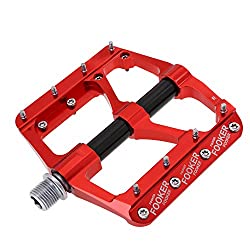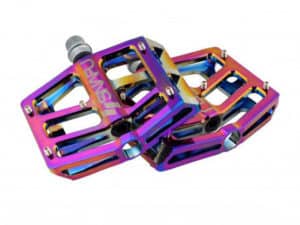While platform pedals are the universal preference for mountain bikes, BMX bike pedals also seem good for mountain bikes because they are strong and optimized for performance. But can you put BMX pedals on mountain bike?
It’s possible to put BMX pedals on an MTB bike provided the cranks and the pedals have a matching 9/16” thread. If there’s no match, you need to either use an adapter or replace the axles before installation.
BMX pedal have a wide plastic platform with small pins that enhance the friction between the pedal and the sole. Inside is a strong Chromoly steel axle and greased ball bearing at each endpoints that allows smooth rotation of the pedal.

Given such as strong and flexible design, and the fact that mountain bike platform pedals have a similar design, it makes a lot of sense why you’d ask if you could put BMX pedals on your MTB bike.
Can You Put BMX Pedals on a Mountain Bike? (4 Reasons)
1. Durability
Just like the bikes themselves, BMX pedals are tough and well built.
Manufacturers make them from tough composite materials and then subject them to conditions far much worse than you ever will in real life before releasing them to the market.
If you think about it, there’s a lot of grinding on the ledges and that increases the chances of hitting the pedals. That means they can stand up to hard riding and handle outrageous stunts.
2. Looks
I personally love these pedals because they have a street look that makes them stand out from the crowd.
Moreover, they have a super low profile, they’re lightweight, and their durable finish makes them the best pedals out there.
3. Solid Grip
BMX bikes are grippy for a reason.
Think about it.
You’ll do many BMX tricks such as Bar Turn, Euro Table, Spine Transfer, fun box jumping, bar spin, and bunny hops. If anything, you need grippy pedals to facilitate the performance of such trick.
BMX bike pedals have pins to offer plenty of grip.
4. Affordable
I have never in my cycling life thought that bike pedals made of tough durable steel would be anything close to cheap.
But BMX pedals seems to break this rule and come at a fairly decent price that any biker can afford.
Are BMX Pedals the Same as Mountain Bike Pedals?
Modern BMX pedals are similar to mountain bike pedals because their cranks use the 9/16” threads. Some BMX pedals features 1/2″ threads and can’t fit onto the cranks of MTBs unless with the help of a 1/2″ to 9/16” thread converter.
Keep in mind that manufacturers don’t make the 1/2” thread pedals that much anymore. What you will find are mostly 9/16” threads, which are the current standard for BMX bikes.
Given that mountain bikes use 9/16”, you should not have an issue with BMX pedals on a mountain bike.
One difference between the two is that BMX pedals are made of plastic. And while the material is universally accepted as solid, the plastic tends to wear down rather quickly. MBT pedals are made of aluminum usually because of pedal hits.

Are BMX Pedals Universal?
BMX bike pedals come in 9/16” and 1/2″ threads and are therefore not universal. However, the 9/16” pedals are currently the standard in almost all modern BMX bike.
The 1/2″ thread pedals, on the other hand, are becoming less common as manufacturers are producing them less.
If bike pedals were universal, it would be easier for roadies to find models that fit into any crank straight out of the box. That means interchanging between Mountain Bike and Bicycling Motocross pedals would be a lot easier.
Unfortunately, that’s not the case.
The 9/16” thread is the standard pedal configuration and is common in modern adult bikes and 2-piece and 3-piece BMX bikes.
The 1/2″ thread pedals, on the other hand, are common with juvenile and inexpensive adult bikes. You are also likely to see them on 1-pieice BMX bikes.
It’s important to note that there’s no difference in performance between these two types of pedal configuration.

What Type of Pedals are Best for Mountain Biking?
Platform and clipless bike pedals are the best for mountain biking. Platform pedal feature a flat, slip-resistant, and lightweight design that easily accommodates any type of footwear.
Clipless pedals are ideal for mountain bikers who do stunts (or complex tricks) such as speed racing or ride on rough terrains.
Here’s a detailed explanation of clipless and platform bike pedals.
1. Platform Mountain Bike Pedals
Platform pedals are quite common so it’s easy to see them on bikes designed for riders of all ages. They were first made of plastic.
However, since the plastic construction wasn’t great for gripping (and stable) in wet weather, manufacturers upgraded to more durable materials and thoughtful designs to make them not only lightweight and durable but also slip resistant.
The FOOKER MTB Pedals are by far the best to consider if you need a platform pedal for your mountain bike. They’re durable, easy to install, and have anti-skid nails that hold your feet in place for a more secure pedaling.

2. Clipless Mountain Bike Pedals
A clipless bike pedal is a system with a cleat and the pedal itself.
The cleat mounts on shoes and then clipped on to the pedals. This delvers a more secure fit, allowing you to ride your mountain bike on any kind of terrain.
Clipless bike pedals, such as SHIMANO PD-M8020 are suitable for riders who like to perform a lot more complex cycling tricks such as speed racing and hoping on and off curbs on rough terrains.
How to Put BMX Pedals on a Mountain Bike
You can put BMX pedals on a mountain bike if the threading of the axle matches that of the cranks.
MTB and BMX pedals for 2 and 3-piece cranks are interchangeable as they both have 9/16” pedal threads. 1-piece BMX pedals have 1/2″ threads, so their axles are too thin to fit on a mountain bike.
Even then, you can still install pedals made for 1-piece crank on a mountain bike using a pedal adapter.
How to Install 1/2″ BMX Pedals on MTB Bikes
It’s important to note that MTB and BMX pedals have different threads, so the treads on your MTB bike’ cranks and the pedals may not (won’t) match. However, a couple of tweaks can make a 1/2″ BMX pedals fit perfectly on your MTB.
Here are two methods you can use to make this work.
Method 1: Changing the Axle of the BMX Pedal
This method involves replacing the 1/2″ axles of the BMX pedals with axles made for 2-piece and 3-piece cranks.
Step 1: Disassembling the Pedals
You start by removing the dust cap.
To do this:
- Use a knife or a screwdriver to lift the dust cap.
- Use a 13mm socket and a 15mm pedal wrench to loosen the nut holding the axle.
The wrench will loosen the axle and the socket will untighten the nut.
With the external nut out of the way, the next step is to remove the internal nut and the washer.
You can use this 14mm socket to untighten the nut. Now hold the tread, slide out the axle, and then use a degreaser such as Stanley Home Products Original Degreaser to clean the pedal.
Step 2: The Assembly Stage
In this section, you start by greasing both entrance of the pedal and the entire axle. Put just enough small bearings into the cavities for a smooth rotation of the pedals. Don’t use your hand to put the pedals; you can use tweezers instead.
Slide the axle until the thick part gets into contact with the pedal. Return the internal nut and then use the 14mm socket to tighten it. It should not be too tight.
You have to allow the pedal to spin smoothly and freely, so you should not tighten too tight. Put back the water, tighten the lock nut, and out the dust cap back in place.
Now fix the modified BMX pedals to your MTB cranks, then go out, and enjoy your ride in it.
Method 2: Using Pedal Adapters
The first method I shared is more of a mechanical approach ideal for people who don’t mind to get their hands extremely dirty.
If you just want an easy way out, though, you should consider buying a 1/2″ to 9/16” adapter. I like the Alta Bicycle Pedal Adapter.
Not only does it fit on 9/16” pedals and 1/2″ cranks, it also easily converts the 1/2″ pedals to 9/16” pedals.
Also Read:
Why Does My BMX Squeak When I Pedal?
Final Thoughts
It’s clear that you can put BMX pedals on a mountain bike and get an unbeatable cycling experience. Given that we’ve even recommend a set of pedals to use, swapping between BMX and MTB pedals should be easy.